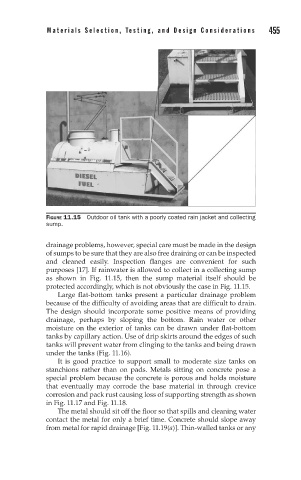Page 488 - Corrosion Engineering Principles and Practice
P. 488
454 C h a p t e r 1 1 M a t e r i a l s S e l e c t i o n , Te s t i n g , a n d D e s i g n C o n s i d e r a t i o n s 455
FIGURE 11.15 Outdoor oil tank with a poorly coated rain jacket and collecting
sump.
drainage problems, however, special care must be made in the design
of sumps to be sure that they are also free draining or can be inspected
and cleaned easily. Inspection flanges are convenient for such
purposes [17]. If rainwater is allowed to collect in a collecting sump
as shown in Fig. 11.15, then the sump material itself should be
protected accordingly, which is not obviously the case in Fig. 11.15.
Large flat-bottom tanks present a particular drainage problem
because of the difficulty of avoiding areas that are difficult to drain.
The design should incorporate some positive means of providing
drainage, perhaps by sloping the bottom. Rain water or other
moisture on the exterior of tanks can be drawn under flat-bottom
tanks by capillary action. Use of drip skirts around the edges of such
tanks will prevent water from clinging to the tanks and being drawn
under the tanks (Fig. 11.16).
It is good practice to support small to moderate size tanks on
stanchions rather than on pads. Metals sitting on concrete pose a
special problem because the concrete is porous and holds moisture
that eventually may corrode the base material in through crevice
corrosion and pack rust causing loss of supporting strength as shown
in Fig. 11.17 and Fig. 11.18.
The metal should sit off the floor so that spills and cleaning water
contact the metal for only a brief time. Concrete should slope away
from metal for rapid drainage [Fig. 11.19(a)]. Thin-walled tanks or any

